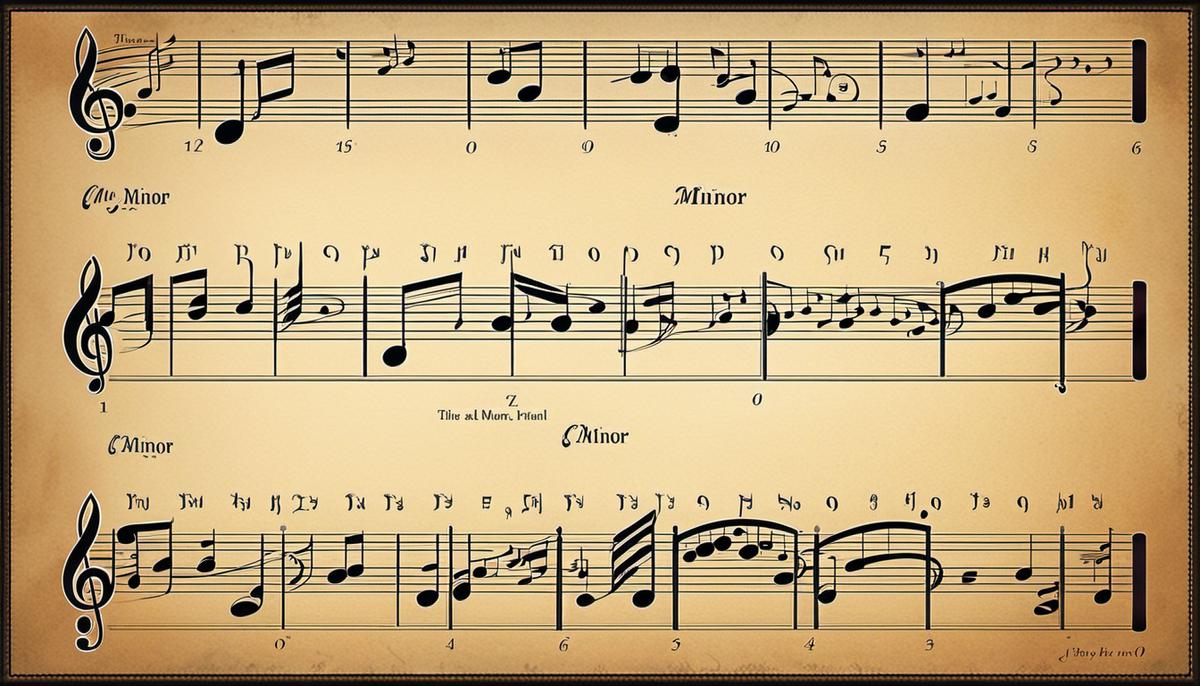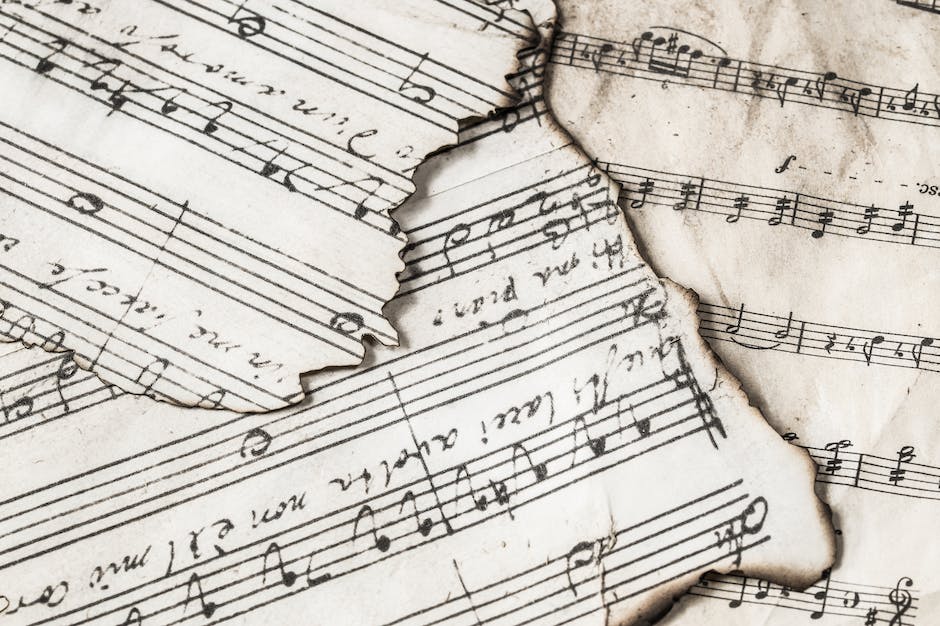
Music, often described as the universal language, is vast and encompasses numerous intricate theories and concepts that are crucial to the creation and interpretation of melodies and harmonies. This essay explores some of these fundamental aspects of music theory, including notes, keys, intervals, chords, melodies, and the core principles of reading music. By delving deeper into the composition and use of major and minor scales, we will venture on a journey of understanding the structural backbone of music, and the emotive power they hold. Going beyond the conventional frames, we also touch upon the various modal scales like Dorian, Phrygian, Lydian, Mixolydian, Aeolian and Locrian modalities. Each of these components plays a major role in the composition and rendition of a musical piece, with choices relating to scales and modes effectively influencing the entire ‘mood’ of the composition.
Introduction to Basic Music Theory
Understanding Music Theory Basics
Music theory involves understanding the components of music such as melody, rhythm, and harmony. This study begins with learning about pitch, which represents the frequency of a note and is categorized as high or low. The higher the frequency, the higher the pitch, and vice versa.
Learning the Musical Alphabet
The musical alphabet runs from A to G and then repeats ongoing from A again. In western music, these letters represent different musical notes. They are the foundation of all music, irrespective of the instrument you are playing.
The Concept of Scales
Scales are a set of musical notes arranged according to frequency or pitch within an octave. The most popular scales are major and minor scales. A major scale follows a pattern of whole and half steps (2 half steps make a whole): Whole, Whole, Half, Whole, Whole, Whole, Half. Starting with any key and following this pattern will give you a major scale. Minor scales have a different step pattern: Whole, Half, Whole, Whole, Half, Whole, Whole, resulting in a sound often described as sadder than major scales.
Discovering Keyboard Keys and Their Names
A simple keyboard has white and black keys, and these keys represent different musical notes. The white keys are given the names of the first seven letters of the alphabet; namely, A, B, C, D, E, F, and G. The black keys represent sharp (#) and flat (b) notes and are named with respect to their adjacent white keys e.g., note between A and B will be A# (A sharp) or Bb (B flat).
Understanding Intervals
An interval in music refers to the distance, in pitch, between two notes. They can be harmonic (played at the same time) or melodic (played separately). Knowing intervals is useful for understanding chords and scales. Basic intervals include unisons, seconds, thirds, fourths, fifths, sixths, sevenths, and octaves.
Defining Chords and Melodies
A chord is defined as three or more musical notes played together, while a melody is a sequence of notes played in a rhythmic manner. Chords are essential for providing a harmonious base for melodies.
Reading Sheet Music
Avoiding sheet music is not an option when one wants to master music theory. Understanding a staff, clefs (bass and treble), note symbols, rest symbols, and key signatures is integral to reading music.
Understanding Tempo, Rhythm, and Beats
Tempo refers to the speed or pace of a piece of music, measured in BPM (beats per minute). Rhythm is the pattern of beats and silences, while a beat is the basic time unit of music. These elements impact the feel and mood of the music. Rhythm can be simple or complex, and tempo can range from slow (largo) to fast (presto).
By grasping these basics of music theory, you will be well on your way to understanding the language of music. Remember, practice is the key to mastering these concepts.

Major and Minor Scales
Understanding Major and Minor Scales
The construction of major and minor scales is based on musical intervals, typically tones and semitones. These scales contain seven different notes. In both major and minor scales, the key or tonic note (the first note of the scale) is of utmost importance. This is the note that gives the scale its name.
A major scale follows a sequence of intervals (semitones and tones) as: Tone – Tone – Semitone – Tone – Tone – Tone – Semitone. The C Major scale, for instance, would play out as: C – D – E – F – G – A – B – C.
Minor scales, on the other hand, follow a different pattern: Tone – Semitone – Tone – Tone – Semitone – Tone – Tone. The A minor scale, for instance, goes: A – B – C – D – E – F – G – A.
The Importance of Tonic
The tonic is the first note of a scale and it provides the home base around which the music evolves. It is the most stable and conclusive sounding note in any key. All other notes in the key have varying degrees of tension and release to this tonic note. In other words, the tonic note is the gravitational center of any scale.
Dominance of the Dominant
The term “dominant” refers to the fifth note in any major or minor scale. This note is only second in importance to the tonic. The dominant note of a scale carries an inherent tension that seeks to resolve in a particular direction, usually back to the tonic. This tension-and-resolve dynamic creates motion and progression in music, making the dominant a crucial aspect of musical structure.
Emotional Implication of Major and Minor Scales
Major and minor scales convey different emotions in music. Major scales generally have a happy, bright, or triumphant sound, while minor scales tend to evoke feelings of sadness, solemnness, or reflection. This makes the choice between major and minor an essential aspect of setting the emotional tone of a piece of music. However, emotions in music are multi-faceted and can overlap, so although major might usually sound happy and minor sad, the full emotional spectrum in each is much broader.
Remember that different moods can be achieved through the various scales and keys in music. So, try experimenting with different scales to find the tone and mood you want to set. As you delve more into music theory, you will find that scale choice is just one of the many tools musicians use to create feeling and expression in their work.

Modes and Modal Scales
Understanding Modes in Music
The term “mode” in music refers to the different ways in which scales can be constructed. Specifically, these modes are named Dorian, Phrygian, Lydian, Mixolydian, Aeolian, and Locrian. Despite their exotic names, these modes are quite simple to understand if you’re already familiar with basic major and minor scales. Each mode starts from a different note of the major scale and retains the original order of tones and semitones.
Dorian Mode
The Dorian mode is similar to the natural minor scale but with a raised 6th note. For instance, if we take the C Major scale and start at D, we would have: D, E, F, G, A, B, C, D. The “Dorian” sound is described as somewhat melancholic, but less so than the regular minor scale.
Phrygian Mode
The Phrygian mode begins on the third note of the major scale. For example, in the C Major scale, the Phrygian mode starts from E: E, F, G, A, B, C, D, E. Phrygian mode has a characteristically Spanish or Eastern sound because of the semitone interval between the first two notes.
Lydian Mode
The Lydian mode is built from the fourth note of the major scale. Its structure in the key of C starts from F: F, G, A, B, C, D, E, F. The Lydian mode differs from the major scale by its raised 4th note, giving it an uplifting and ethereal sonic quality.
Mixolydian Mode
The Mixolydian mode starts from the fifth note of the major scale. For the C Major scale, the Mixolydian mode would begin from G: G, A, B, C, D, E, F, G. With its lowered 7th note compared to the major scale, Mixolydian mode brings a bluesy and down-to-earth feel to the music.
Aeolian Mode
The Aeolian mode also known as the natural minor scale, originates from the sixth note of the major scale. In the C Major scale, the Aeolian Mode goes from A: A, B, C, D, E, F, G, A. It’s characterized by its sad, melodic quality, creating the classic minor key sound.
Locrian Mode
Lastly, the Locrian mode starts from the seventh note of the major scale. In the C Major scale, it goes from B: B, C, D, E, F, G, A, B. It’s the only mode with a flattened 2nd and 5th, which gives it an unsettling, tense sound that’s seldom used in Western music.
In conclusion, understanding modes beyond the basic Major and Minor scales open a vast realm of creative possibilities for composers and players alike. From the melancholy Dorian to the exotically tense Locrian, each mode offers a unique sonic color to explore.

Application of Scales in Music Composition
Understanding Scales
In music theory, a scale is a collection of pitches in ascending or descending order. The most common scales in Western music are major and minor scales – known for their distinct and recognizable sound characteristics. They are used as the building blocks for creating melodies and harmonies.
Application of Scales in Music Composition
To effectively apply scales in music composition, you first need to choose the appropriate one. This could depend on the overall mood or tone that you want to set for the piece. A major scale generally conveys positivity and joy, while a minor scale tends to express sadness or melancholy.
Using Major Scales
Major scales are constructed with a specific pattern of whole and half steps, which are the distances or intervals between pitches. The major scale pattern is: Whole, Whole, Half, Whole, Whole, Whole, Half. This series of intervals creates the familiar and accessible sound that is typical of most popular and classical music. In a composition, you might opt to use a major scale if you were attempting to create a cheerful or triumphant musical mood.
Using Minor Scales
Minor scales have a slightly different pattern of intervals, characterized by a melancholic or more serious mood. The natural minor scale pattern is: Whole, Half, Whole, Whole, Half, Whole, Whole. Compositions employing the minor scale often bring depth and introspection, often found in genres like blues, jazz, and some forms of rock and pop.
Exploring Different Scales
Apart from the major and minor scales, there are numerous other scales that you can try in your composition endeavor. The blues scale, pentatonic scale, chromatic scale, are examples of other unique scales that can allow your music to stand out. These scales are commonly used in certain genres to evoke specific moods or tonal colors.
Connecting the Scales to Modes
When a scale starts and ends on a different note, still using the same series of pitches, it creates a mode. Modes are crucial in setting the mood or flavor of the song. Knowing your modes can give you endless potential for experimentations in your compositions.
Scales in Harmony
Aside from melody, scales are also important in forming the harmony of a piece. The harmonization of a scale is the process of creating chords from its various degrees. For example, in the key of C major, the C major chord (C-E-G) is the first degree, the D minor chord (D-F-A) is the second degree, and so on. This process results in a series of chords that correspond to each note of the scale, which can be used to create chord progressions, and therefore structure, in your compositions.
Understanding and exploring scales in your music can greatly enhance your composition skills. They provide the basic framework for creating melodically and harmonically coherent pieces while allowing you to experiment with tonality, mood, and styles.

Music theory, scales, and modes shape the wonderfully complex world of music composition. The choice between major and minor scales, or delving into the diverse modal scales, opens up a myriad of possibilities in setting the tone for any musical piece. Furthermore, scales and modes are more than just mere guidelines for creating music – they carry emotional and psychological power that allows music to communicate and captivate. Therefore, developing an understanding of these theoretical constructs gives one a valuable toolkit to appreciate, analyze, and craft music in a whole new light. A good grasp of these fundamental elements refines not just the ability to compose, but also enhances the overall musical experience, acting as a bass clef to one’s symphony of music comprehension.
Comments are closed.